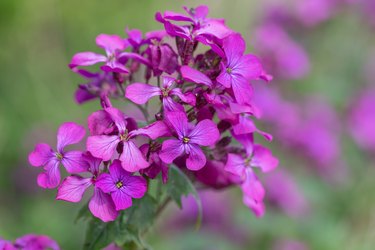
Also known as the honesty plant, money plant and silver dollar plant, the penny flower plant (Lunaria annua) is a biennial species, meaning it dies after two growing seasons. A member of the mustard family, this ornamental is grown for its attractive flowers and interesting seed pods. However, because of its propensity to self-seed, the species has the potential to become invasive. The penny flower plant is winter hardy in U.S. Department of Agriculture plant hardiness zones 5 to 9.
Penny Flower Plant Characteristics
Video of the Day
Penny flower plants are considered tall plants, with a typical height between 2 and 3 feet. They have hairy stems, while the leaves are pointy and oval-shaped with serrated edges. This species flowers in mid to early spring of the plant's second year, usually sometime in April and May.
Video of the Day
Penny flowers are quite fragrant and usually purple or magenta in color. There is another variety with white flowers (Lunaria annua var. alba); however, it can be harder to find. Each penny flower is 1/2 inch across and has exactly four petals. The flowers grow in clusters on stalks called racemes that emerge in the spring of the plant's second year, lasting for about two or three weeks. The blooms of the penny plant are prized as dried cut flowers.
The distinctive feature of a penny flower plant is its flat, thin seed pods, which resemble coins, hence the common name of the species. The circular shape of the seed pod is also the inspiration behind the genus name Lunaria, which is a reference to the Latin word for "moon." The seed pods are green at first and become almost see-through as they mature. These seed pods are formally known as silicles and are often collected and dried to use in flower arrangements. You can also save some seed pods for future plantings.
Growing Penny Flower Plants
Moist garden and woodland soils that drain well and contain organic matter work well for penny plants. You can sow seeds directly into the garden bed once the soil becomes workable in the spring. These plants can be grown in full sun in cool climates, but in the southern portions of its range, it benefits from some shade from the hot afternoon sun.
Before growing this species, however, you should be aware that it self-seeds easily and as a result has become invasive in parts of the U.S. and southern Canada. Therefore, once you plant penny flowers in your garden, they are almost impossible to eliminate.
Penny Flower Plant Care
Penny flower plants are considered low-maintenance plants. If necessary, you can fertilize penny plants in the spring once new growth has emerged. A complete organic or slow-release fertilizer is appropriate.
As biennials, in their first year, penny plants do not produce flowers or seed pods, only leaves. Therefore, if you want to enjoy the flowers every spring instead of every other spring, you should plant penny flower seeds in two consecutive years. In the warmest parts of its range, you can also opt to sow seeds in the fall for a spring bloom the following spring.